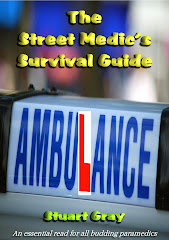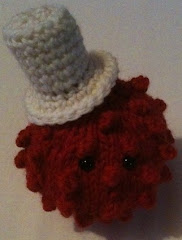 Night shift: Nine calls; five by car; two assisted-only; two by ambulance.
Night shift: Nine calls; five by car; two assisted-only; two by ambulance.Stats: 1 Abdo pain; 1 RTC (2 people, no injuries); 1 Asthma; 4 eTOH; 1 Vulnerable adult; 1 No trace.
Sometimes a patient will experience pain of an undetermined origin and my first call took me to an 18 year-old girl who had this problem – in fact, she’d had it for 5 years on and off. She was complaining of severe sharp pain in her lower right abdomen. She also felt dizzy and sick with it. I found her sitting outside with her friend. She was hugging the painful area as if it would go away if it was held long enough. She’d had all the usual tests done but nothing had ever been found wrong – they’d taken away her appendix and she’d undergone a laparoscopy investigation to see if her ovary was to blame but that drew a blank. Now she was living with it and I took her to hospital in the hope that on a busy St. Patrick’s night, with all and sundry (Irish and mostly non-Irish) using the excuse to become unconscious with alcohol, she’d be given an answer. I wasn’t holding out much hope for her.
Tonight seemed popular with car drivers because there was evidently a need to collide with each other, if the calls coming in were to be judged. I was sent to a two-car collision where a patient was complaining of neck and back pain. This would need an ambulance but when I arrived I was drawn into a medical conversation with one of the drivers, who I had assumed was the neck pain man but he told me about old illnesses that had nothing to do with hitting a car. The van in front of him (the one he hit) was empty of a driver and I found him wandering about and chatting on his mobile phone. This was my neck pain man but again he told me of an old history of back pain and the possibility that it had been exacerbated by the rear-end shunt he’d received from the first man I’d spoken to. It was a little confusing and I knew that an ambulance was on its way but that we could barely spare it on account of the antics of thousands of drunken and soon-to-be drunken ‘Paddy’s day’ revellers. Incidentally, I find it strange that people can go around wearing leprechaun beards and funny tall hats without fear of being branded ‘racist’ but in almost every other aspect of celebratory life there is occasion to worry about who might be offended – just goes to show you that the Irish still have a sense of fun without fearing that their whole nation is under attack. I’m sure we wouldn’t give a hoot if everyone sported tartan shirts and kilts on St. Andrew’s day (but few people know or care when that is down here primarily because it is not associated with getting blind drunk).
Anyway, I cancelled the ambulance and waited for the police to get their stories written down before leaving the two colliding gentlemen to it. I didn’t get far though because the first man hailed me back to him and told me his car wouldn’t start. The battery was flat and he had no affiliation with any rescue service. The police were still on scene and we planned to push his vehicle onto the kerb and let him work out how to get home but he’d been acting strangely – he was very unstable at times on his feet, although alcohol had been ruled out earlier. This was one of those calls where I felt something wasn’t right but I couldn’t put my finger on it. The cops asked him some searching questions and he became a little erratic with his answers, so they looked in his car. There they found two heavy wooden rolling pins on the floor. Obviously, these are domestic items that can be carried anywhere but two? And on the floor of your car? What would they be used for?
The man was arrested on the spot and, although normally this wouldn’t have gone quite that far, the circumstances surrounding this incident and the man’s general behaviour warranted further investigation by the cops and, flimsy as it may have seemed, they felt he had possible offensive weapons in his possession.
Asthma attacks are pretty well defined but the 15 year-old girl I saw after running on this Red2 emergency could speak to me without drawing breath and she had been unwell recently with a virus, so she wasn’t going to die imminently. She sat up in bed as her family looked on and performed a peak flow test for me; she’s been asthmatic all her life but didn’t seem to know how to do this properly, even though she told me it had been done many times before. Neither did she know her best peak flow. This, I assume, is down to inadequate education about her condition, if she had it at all, and her current state presented no more than an annoying viral cough. The ambulance crew arrived and took her into their vehicle for further checks and she may have been left at home but I was on to my next call before I discovered her fate.
A drunken 56 year-old diabetic man was found lying in the gutter on a tight bend – a bend that practically encourages cars to cut the corner – by two passing MOPs. They called an ambulance and helped me get him into the car as I waited for backup. The man’s BM was high and his temperature was low, neither of which is surprising when someone is that badly drunk. ‘I only drink like this every now and again’, he told me, as if being in this state was some kind of reward.
As I parked up to do my paperwork, a drunken Norwegian man knocked on my window and begged to be taken to his hotel; he’d staggered around lost and was beside himself with worry. The street, which he thankfully remembered, was just around the corner, so I called it in and became his free NHS taxi. At least he was safe and well.
The drunken fun continues with a call to a 22 year-old female who is vomiting in a pub toilet. The landlord is not a happy bunny when he finds out an ambulance has been called to his establishment and he has no knowledge of it so he lays down the law with the American woman and her husband, who is standing at the sinks with her as she throws up into an already well blocked drain. There are four leprechauns sitting like an audience watching this in the ladies loos and they are quickly shoo’d out of the way. The patient’s temperature is low and she is unfit to travel home, even with her husband, so I take them both in the car for the short journey to hospital. The husband apologises profusely, explaining that she’s ‘never been like that before’ and I have to say I accepted his confusion over what to do. In the part of the States where they live it is ‘normal’ for an ambulance to be called when someone is suffering ‘alcohol poisoning’. My definition is much more straightforward – she was drunk on too many pints of Guinness.
Someone else who should blame the drink and not the circumstances was the 25 year-old man found lying in the street. He denied being drunk until his attempt to get up ended in failure and he had to admit, through the fumes of strong alcohol, that he was indeed intoxicated. There were no ambulances available and his temperature, like the others, was dropping below hypothermia, so I got him into the car. He had to be warned when he tried to open the door to get out – obviously the child lock was enabled and he couldn’t. Then, as we approached the hospital he threw up on the floor of the car. I could smell it before I saw it. He made a mad dash for the A&E exit while the nurses ‘ backs were turned but he walked into the wall instead, missing the door by a ninety degree angle and a good few feet.
A common problem for us is frequent flyers – callers who make 999 pleas on a regular basis for no medical reason and end up choking the system. I didn’t know that’s what I had next when I arrived to find a 49 year-old man crouched inside a telephone box. He’d called and said ‘please’ a few times but not much else. I couldn’t get much out of him either, except for his name. Then he told me he’d been abused in the street and started sobbing. I had initially asked for an ambulance because he’d also told me he had ‘heart problems’ but I took him in the car when I discovered that he was known for calling us with this problem. In fact, he was famous for telling everyone he had a ‘broken heart’. He had no cardiac history - he was just sad.
Continuing with the theme of wasted calls, I was asked to investigate a callbox from which an unknown male had dialled 999 with an unknown problem almost two hours earlier. This was a clear-up exercise I guess because when I got there nobody was around – not surprising really.
A 37 year-old man (a large man) knelt at a bus shelter waiting for me. He was still on the phone to the call-taker and waved for me to stop. This wasn’t his first time calling 999 I figured. He was very drunk, could barely walk, barely speak and had no sense of what I and my colleagues were actually around to do. All he wanted was a hospital bed and for no other reason than he wasn’t feeling well. He’d been sick at the bus stop and told me he had diarrhoea. There were no ambulances available and I had to make my usual (now much more detailed) judgment call about whether or not he really needed an ambulance or if I could take him in the car. I offered him the chance to go if he behaved and he waited until I was well underway before announcing that he only hurt people who ‘annoyed him’. Great.
Be safe.















No comments:
Post a Comment